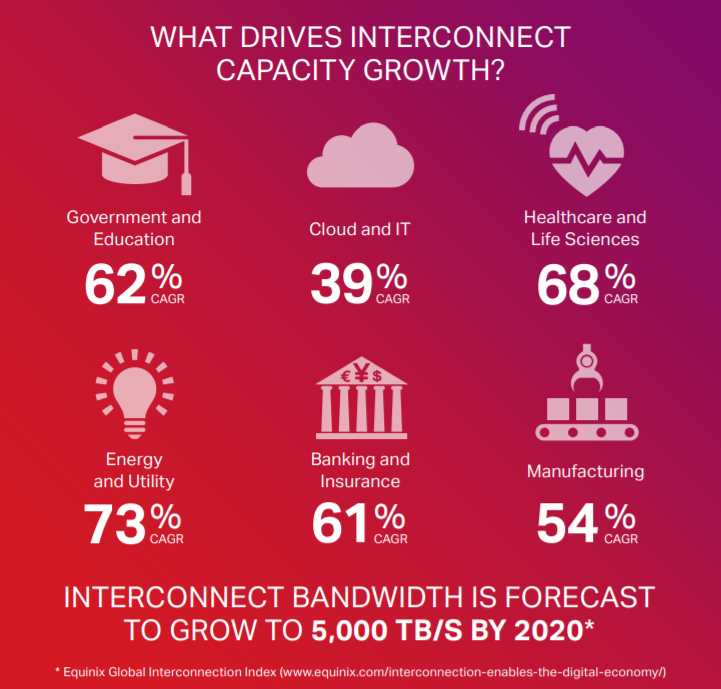4 challenges for data center operators in Japan, and how to solve them
 Japan is a major submarine cable interconnection point between Asia and North America due to its geographical location. Adding to this is the fact that Japan has one of the world’s most advanced telecommunications networks, it is no wonder that Japan is a data center power house. According to Cloudscene, Japan has almost 150 data centers, 183 service providers and 4 network fabrics throughout the country.
Japan is a major submarine cable interconnection point between Asia and North America due to its geographical location. Adding to this is the fact that Japan has one of the world’s most advanced telecommunications networks, it is no wonder that Japan is a data center power house. According to Cloudscene, Japan has almost 150 data centers, 183 service providers and 4 network fabrics throughout the country.
Data Center Interconnect (DCI) capacity, or the traffic between data centers, is projected to grow at nearly 2X the rate of public Internet traffic growth by 2020. In fact, Interconnect bandwidth is forecast to grow to 5,000 Terabytes by 2020. Japan, being the leader in adopting advanced communications technology, is one of the first to see the surge in DCI bandwidth requirements. The onset of this market trend will bring about a few challenges for data center operators in Japan:
- Distance Limitations: Data centers often require a connection with minimum latency to maintain a proper flow of information and synchronization between the server sending the information and the storage device saving it. When data centers that need to be connected are far apart, the latency increases as a function of the distance between the data centers and the network equipment that interconnects them. While choosing the shortest physical route can minimize fiber-induced latency, software- and equipment-induced latency must be kept to a minimum with proper design practices.
- Capacity: Very often, the aggregate size of application data sets entering or leaving the data center can be very large—hundreds of Gigabits, or even terabits—so the networking equipment connecting to the data center must provide reliable, high-capacity connections that can be scaled to higher rates as required.
- Operations: Manual network operations are labor-intensive, complex, slow, and can be highly error-prone. Minimizing manual operations by automating frequent and recurring tasks is an operational imperative. Turning up a connection between two data centers should be rapid and reliable, and managing this connection should not require ongoing manual operational tasks.
- Cost: With expected traffic growth between data centers approaching 30 percent CAGR, network costs must grow at a much slower rate if a data center is to remain financially viable into the future.

These are indeed daunting challenges. However, data center operators in Japan can look to DCI technology innovations in these areas to get ahead of the curve:
- Overcoming distance limitations with Digital Signal Processing (DSP): Fiber impairments such as chromatic or polarization mode dispersion—which have long been roadblocks to implementing high-bandwidth connectivity over long distances—are no longer an issue. Breakthroughs in DSP technology have allowed networking equipment providers to introduce packet-optical platforms capable of automatically and intelligently compensating for these fiber-optic transmission effects, allowing large data flows to be carried over several thousands of kilometers over different fiber types, without compromising speed for performance.
- Overcoming capacity limitation with coherent optics: Coherent optics paved the way to successful transmission of data at 40 Gb/s and beyond, over almost any distance. Coherent detection created a major increase in transport capacity, a key requirement for today’s DCI.
- Overcoming network latency with high-performance and ultra-high-speed optoelectronics: Sophisticated hardware design, optimized software engines, innovative Forward Error Correction (FEC) schemes, and high-performance optoelectronics have significantly reduced network equipment-related latency. Minimizing latency is a key factor in the successful implementation of numerous data center-related applications such as data mirroring.
- Overcoming manual operations with programmable automation: Data center networks are constantly changing, resulting in traffic trends that are difficult to predict, given the spontaneous access to the resource pool by a wide variety of users and applications. Operational tasks can be automated with APIs and associated applications, allowing end-users to create custom applications that execute bandwidth increase requests, set up new connections between two endpoints, modify an existing connection, and perform many other tasks required in daily data center-to-data center operations, without any intervention.
- Overcoming cost increases through application-optimized platforms: Today’s latest optical platforms are meticulously designed and purpose-built around DCI applications. Simple planning, ordering, and installation allow data centers to be interconnected faster. Full programmability allows data center operators to design and build applications for their specific operational needs. High speed in a small footprint connects data centers with the lowest cost-per-bit. Small footprint and low power consumption directly and positively impact operating costs, while modularity allows scaling to multiple terabits of transport capacity without massive hikes in CAPEX/OPEX.
Ciena’s DCI Solutions for Your Data Center Interconnect
Market research firm Ovum recognizes Ciena as the DCI industry’s networking leader and we continue to push the envelope to deliver market leading DCI technology. This is evident in our newest portfolio of DCI technology which includes:
- Waveserver Ai is designed to address evolving density and power requirements for ultra-high-capacity interconnect applications. Waveserver Ai’s modular architecture offers both rack-and-stack simplicity as well as pay-as-you grow scalability. And because it incorporates Ciena’s WaveLogic Ai coherent optical technology, it delivers the scalability required to satisfy the largest interconnect requirements—from metro to ultra-long-haul distances. It provides unique, industry-leading per-wavelength capacity of up to 400 Gb/s.
- Ciena’s 8180 Coherent Networking Platform combines the industry-leading capacity and embedded intelligence of WaveLogic coherent transport with the density, openness, and programmability of a packet switch. As part of an end-to-end solution that peers with both packet switch devices and coherent networking platforms, it provides a high-density on-ramp to the coherent optical network.
- Ciena’s 5170 Service Aggregation Switch is purpose-built to provide seamless MEF-compliant services over a carrier-class, connection-oriented infrastructure. It enables 100GbE service delivery or 10GbE service aggregation in an energy and footprint efficient form factor.
- Ciena’s Blue Planet Manage, Control and Plan (MCP) software allows operators to unify all aspects of operations across Ciena’s optical and packet network assets, with consistency, reliability, and speed. Blue Planet MCP’s modern, extensible architecture evolves network operations with real-time, software-defined programmability to drive service agility.
- Liquid Spectrum combines variable bit-rate coherent optics, a flexible grid reconfigurable photonic layer, and SDN control in an open architecture to improve visibility, automate processes, and increase network capacity and service availability from any given WDM investment.




